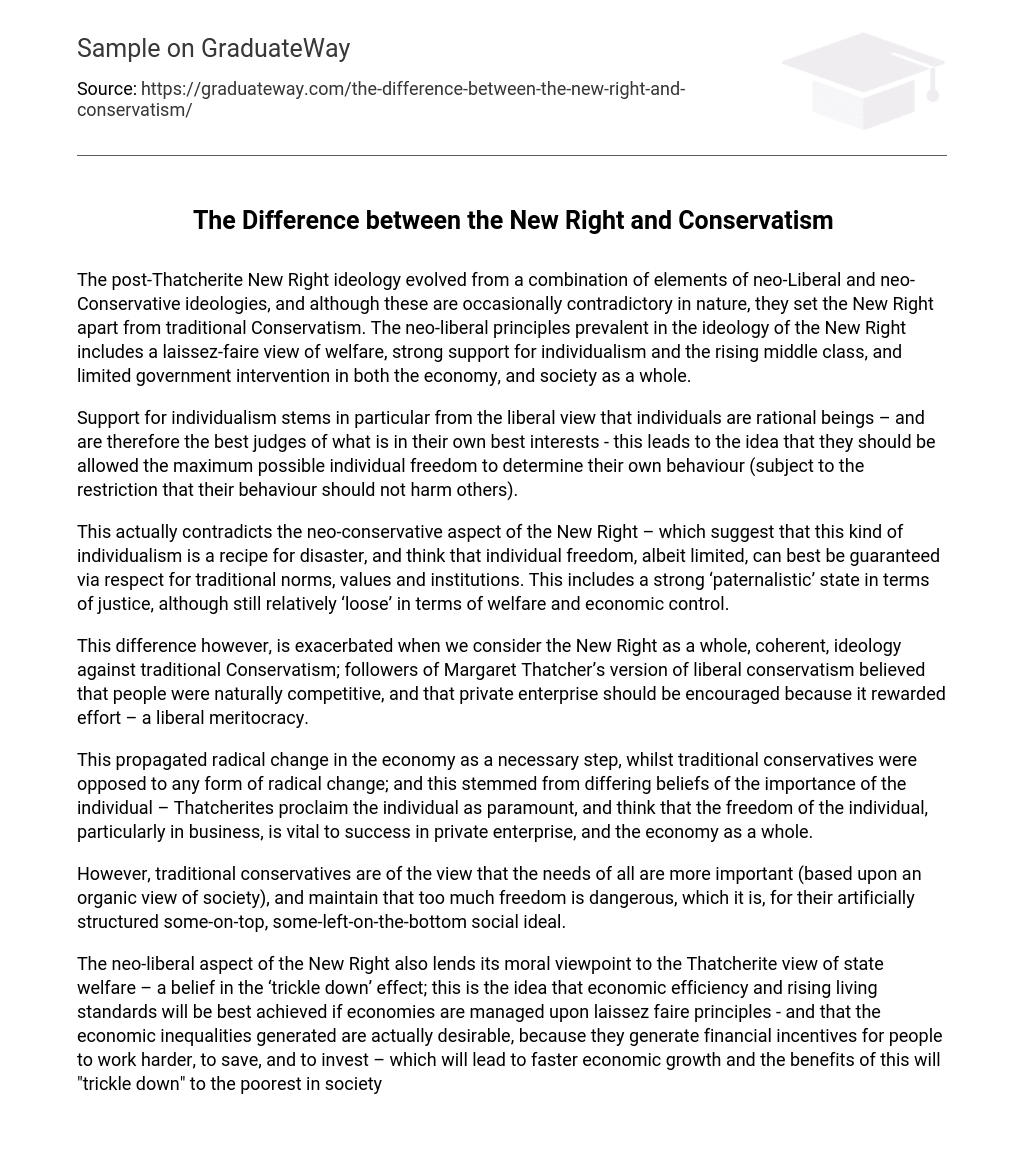The New Right ideology that arose after Margaret Thatcher blends elements from both neo-Liberal and neo-Conservative ideologies, despite occasional conflicts. These distinctions set the New Right apart from traditional Conservatism. The New Right encompasses principles of neo-liberalism such as a non-interventionist stance towards welfare, strong backing for individualism and the expanding middle class, and limited government involvement in both the economy and society.
Individualism is supported because it assumes individuals are rational and capable of making optimal decisions for themselves. This viewpoint is commonly linked to liberalism, advocating for maximum personal freedom as long as it does not harm others.
The argument presented contradicts the neo-conservative aspect of the New Right. The New Right argues that this kind of individualism is a recipe for disaster and that individual freedom, although limited, is best ensured through adherence to traditional norms, values, and institutions. This includes advocating for a strong ‘paternalistic’ state in matters of justice while maintaining a relatively ‘loose’ approach to welfare and economic control.
This difference, however, is magnified when we compare the New Right, viewed as a comprehensive and unified ideology, to traditional Conservatism. Supporters of Margaret Thatcher’s brand of liberal conservatism maintained that individuals are inherently competitive and that private businesses should be promoted because they incentivize hard work. This ideology promotes a liberal meritocracy.
This led to a significant transformation in the economy, which was seen as essential by some but strongly opposed by traditional conservatives. The divide was based on differing views regarding the significance of the individual. Thatcherites firmly believed in prioritizing the individual and considered the freedom of the individual, especially in business, crucial for success in private enterprise and the overall economy.
On one hand, traditional conservatives believe that the prioritization of the collective needs, based on their organic view of society, is paramount. On the other hand, they argue that excessive freedom can be perilous, particularly in relation to their social ideal that artificially classifies some individuals above others.
The perspective on state welfare by the New Right, which is influenced by neo-liberalism, aligns with Thatcherite ideology. They support the idea of the ‘trickle down’ effect, advocating for laissez-faire principles in managing economies. According to this viewpoint, economic efficiency and better living standards can be achieved while accepting and even embracing economic inequalities. These disparities are seen as beneficial since they provide individuals with financial motivation to work harder, save, and invest. Consequently, this approach aims to promote accelerated economic growth that will ultimately improve the lives of society’s most disadvantaged members.
However, traditional conservatives strongly oppose this view, despite not holding socialist views on welfarism, as they believe a welfare state is essential.
Both groups in the New Right have contrasting perspectives on state governance. While the neo-conservatives advocate for maintaining the current social order with minimal changes and support traditional sources of authority and institutions, they also advocate for a strong but limited government. On the other hand, the neo-liberal aspect of the New Right entails a general opposition towards trade unions and unelected bodies like pressure groups.
The text outlines the suspicions of the New Right towards trade unions and local government bodies. However, traditional conservatives acknowledge the significance of trade unions and are open to cooperating and listening to their perspectives. They also support local government, recognizing its role in maintaining the state. Both Thatcherism and traditional conservatism advocate for a strong state to uphold law and order and to enhance the involvement of central government in providing education, which they believe is failing to meet the needs of the capitalist economy. While there are some noticeable differences between the New Right’s liberal and conservative views, they are overshadowed by their similarities with traditional conservatism.
In summary, although there are notable distinctions, particularly regarding the economy and individuals, there are also aspects where they share similar ideologies. The neo-liberal impact on Thatcherite principles played a significant role in diverting the ideology of the New Right from traditional Conservatism and pushing it towards a new and more radical direction.





